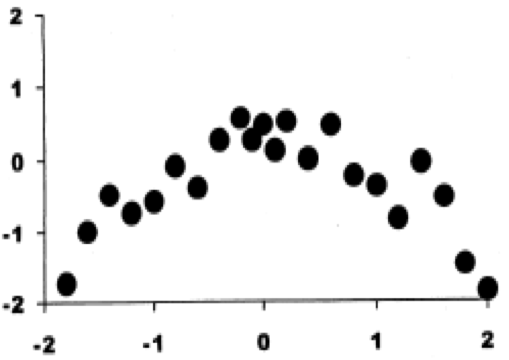StatTutor Lesson - Facts about correlation
true
Stat Tutor
true
true
You have completed 0 question sequences out of 6.
Question 1
42
Question 1.
True or false: The sign on r always denotes the direction of the relationship.
| A. |
| B. |
Correct. This is a correct statement.
Incorrect. This is a correct statement.
2
Try again.
Question 2
77
Question 2.
True or false: A value of r = –1.5 has to be an error.
| A. |
| B. |
Correct. This is a correct statement.
Incorrect. This is a correct statement.
2
Try again.
Questions 3-4
157
Question 3.
If we change the unit of measure for X from centimeters to feet, will the value of r change?
| A. |
| B. |
Correct. Changing the unit of measure for X or Y does not change “r” because “r” is computed using z-scores which have no unit of measure.
Incorrect. Changing the unit of measure for X or Y does not change “r” because “r” is computed using z-scores which have no unit of measure.
2
Try again.
Question 5
207
Question 5.

True or false: Computing r as a measure of the relationship between X and Y is misleading for the data in the above scatterplot.
| A. |
| B. |
Correct. “r” should only be computed when the relationship between X and Y is linear; when the relationship is not linear, “r” is misleading.
Incorrect. “r” should only be computed when the relationship between X and Y is linear; when the relationship is not linear, “r” is misleading.
2
Try again.
Question 6
243
Question 6.
True or false: r is resistant to outliers.
| A. |
| B. |
Correct. An outlier can either pull r closer to +1.0, –1.0 or 0.0 depending on where the outlier is relative to the other data.
Incorrect. An outlier can either pull r closer to +1.0, –1.0 or 0.0 depending on where the outlier is relative to the other data.
2
Try again.
Question 7
298
Question 7.
Suppose someone claims a strong correlation between salary and gender. What should you conclude?
| A. |
| B. |
| C. |
Correct. “r” is computed from bivariate quantitative data. You should never compute “r” with categorical data. In this claim, correlation may not have been computed, but rather the term “correlation” is used incorrectly.
Incorrect. “r” is computed from bivariate quantitative data. You should never compute “r” with categorical data. In this claim, correlation may not have been computed, but rather the term “correlation” is used incorrectly.
2
Try again.